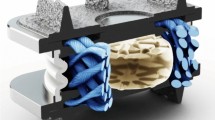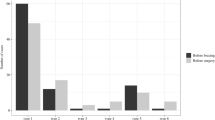Abstract
Purpose
Cervical arthroplasty is being used as an alternative for cervical fusion, but long-term follow-up results have rarely been reported. In this paper, we present 10-year follow-up results after implantation of the Bryan Cervical Disc Prosthesis in a single center.
Methods
89 patients underwent implantation of a single-level Bryan Cervical Disc Prosthesis to treat radiculopathy and/or myelopathy. Clinical (Neurological Success, Neck Disability Index (NDI), Neck- and Arm-Pain, and SF-36) and radiological follow-up was prospectively organized up to 10 years after surgery. Adverse events and second surgeries were recorded and evaluated.
Results
Ten-year follow-up data were available for 72 (81%) patients. Maintenance or improvement of the neurological state was seen in 89% of patients after 10-year follow-up. SF-36 PCS scores improved significantly at all follow-up points. SF-36 MCS improvement was significant at 4 and 6 year, but not at 8- and 10-year follow-up. Significant improvement for NDI, and Neck- and Arm-Pain scores was found for the subgroup of patients in whom these data were available. Mean angular motion of the prosthesis at 10-year follow-up was 8.6°. Mobility of the device, defined as >2° of angular motion, was reached in 81% of patients. During the study period, 21 patients (24%) developed new or recurrent radiculopathy or myelopathy, the majority of these being treated conservatively. Seven patients (8%) required 8 additional spine surgeries to treat persistent or recurrent symptoms. Of these, 2 patients (2%) were reoperated at the index level and at 5 (6%) an adjacent level.
Conclusion
In this study, favorable long-term clinical outcome after implantation of the Bryan Cervical Disc Prosthesis was seen, with the majority of prostheses remaining mobile after 10-year follow-up. However, still 6% of patients required adjacent level surgery.





Similar content being viewed by others
References
Goffin J, Geusens E, Vantomme N et al (2004) Long-term follow-up after interbody fusion of the cervical spine. J Spinal Disord Tech 17:79–85
Hilibrand AS, Carlson GD, Palumbo MA et al (1999) Radiculopathy and myelopathy at segments adjacent to the site of a previous anterior cervical arthrodesis. J Bone Joint Surg Am 81:519–528
Helgeson MD, Bevevino AJ, Hilibrand AS (2013) Update on the evidence for adjacent segment degeneration and disease. Spine J 13:342–351. doi:10.1016/j.spinee.2012.12.009
Matsumoto M, Okada E, Ichihara D et al (2010) Anterior cervical decompression and fusion accelerates adjacent segment degeneration: comparison with asymptomatic volunteers in a ten-year magnetic resonance imaging follow-up study. Spine (Phila Pa 1976) 35:36–43. doi:10.1097/BRS.0b013e3181b8a80d
Heller JG, Sasso RC, Papadopoulos SM et al (2009) Comparison of Byan cervical disc arthroplasty with anterior cervical decompression and fusion. Spine (Phila Pa 1976) 34:101–107
Sasso RC, Anderson PA, Riew KD, Heller JG (2011) Results of cervical arthroplasty compared with anterior discectomy and fusion: four-year clinical outcomes in a prospective, randomized controlled trial. J Bone Jt Surg 93:1684–1692
Mummaneni PV, Burkus JK, Haid RW et al (2007) Clinical and radiographic analysis of cervical disc arthroplasty compared with allograft fusion: a randomized controlled clinical trial. J Neurosurg Spine 6:198–209. doi:10.3171/spi.2007.6.3.198
Burkus JK, Haid RW, Traynelis VC, Mummaneni PV (2010) Long-term clinical and radiographic outcomes of cervical disc replacement with the Prestige disc: results from a prospective randomized controlled clinical trial. J Neurosurg Spine 13:308–318. doi:10.3171/2010.3.SPINE09513
Burkus JK, Traynelis VC, Haid RW, Mummaneni PV (2014) Clinical and radiographic analysis of an artificial cervical disc: 7-year follow-up from the Prestige prospective randomized controlled clinical trial. J Neurosurg Spine 21:516–528
Murrey D, Janssen M, Delamarter R et al (2009) Results of the prospective, randomized, controlled multicenter Food and Drug Administration investigational device exemption study of the ProDisc-C total disc replacement versus anterior discectomy and fusion for the treatment of 1-level symptomatic cervi. Spine J 9:275–286. doi:10.1016/j.spinee.2008.05.006
Zigler JE, Delamarter R, Murrey D et al (2013) ProDisc-C and anterior cervical discectomy and fusion as surgical treatment for single-level cervical symptomatic degenerative disc disease: five-year results of a Food and Drug Administration study. Spine (Phila Pa 1976) 38:203–209. doi:10.1097/BRS.0b013e318278eb38
Hisey M, Bae H, Davis R et al (2014) Multicenter, prospective, randomized, controlled investigational device exemption study comparing mobi-C® cervical artificial disc to anterior fusion in the treatment of symptomatic cervical degenerative disc disease. Int J Spine Surg. doi:10.1016/j.spinee.2011.08.051
Hisey MS, Bae HW, Davis RJ et al (2015) Prospective, randomized comparison of cervical total disk replacement versus anterior cervical fusion. J Spinal Disord Tech 28:237–243
Phillips FM, Lee JYB, Geisler FH et al (2013) A prospective, randomized, controlled clinical investigation comparing PCM cervical disc arthroplasty with anterior cervical discectomy and fusion. 2-year results from the US FDA IDE clinical trial. Spine (Phila Pa 1976) 38:E907–E918. doi:10.1097/BRS.0b013e318296232f
Phillips FM, Geisler FH, Gilder KM et al (2015) Long-term outcomes of the US FDA IDE prospective, randomized controlled clinical trial comparing PCM cervical disc arthroplasty with anterior cervical discectomy and fusion. Spine (Phila Pa 1976) 40:674–683. doi:10.1097/BRS.0000000000000869
Tumialán LM, Gluf WM (2011) Progressive vertebral body osteolysis after cervical disc arthroplasty. Spine (Phila Pa 1976) 36:E973–E978. doi:10.1097/BRS.0b013e3181fd863b
Fan H, Wu S, Wu Z et al (2012) Implant failure of Bryan cervical disc due to broken polyurethane sheath: a case report. Spine (Phila Pa 1976) 37:E814–E816. doi:10.1097/BRS.0b013e3182477d85
Goffin J, Casey A, Kehr P et al (2002) Preliminary clinical experience with the Bryan cervical disc prosthesis. Neurosurgery 51:840–847. doi:10.1227/01.NEU.0000026100.14273.B3
Goffin J, Van Calenbergh F, van Loon J et al (2003) Intermediate follow-up after treatment of degenerative disc disease with the Bryan Cervical Disc Prosthesis: single-level and bi-level. Spine (Phila Pa 1976) 28:2673–2678. doi:10.1097/01.BRS.0000099392.90849.AA
Goffin J, van Loon J, Van Calenbergh F, Lipscomb B (2010) A clinical analysis of 4- and 6-year follow-up results after cervical disc replacement surgery using the Bryan Cervical Disc Prosthesis. J Neurosurg Spine 12:261–269. doi:10.3171/2009.9.SPINE09129
McHorney CA, Ware JEJ, Lu J, Sherbourne C (1994) The MOS 36-Item Short-Form Health Survey (SF-36): III. Tests of Data Quality, Scaling Assumptions, and Reliability across Diverse Patient Groups. Med Care 32:40–66
Vernon H, Mior S (1991) The neck disability index: a study of reliability and validity. J Manip Physiol Ther 14:409–415
Walraevens J, Demaerel P, Suetens P et al (2010) Longitudinal prospective long-term radiographic follow-up after treatment of single-level cervical disk disease with the Bryan Cervical Disc. Neurosurgery 67:679–687. doi:10.1227/01.NEU.0000377039.89725.F3 (discussion 687)
Quan GMY, Vital J-M, Hansen S, Pointillart V (2011) Eight-year clinical and radiological follow-up of the Bryan cervical disc arthroplasty. Spine (Phila Pa 1976) 36:639–646. doi:10.1097/BRS.0b013e3181dc9b51
Zhang Z, Zhu W, Zhu L, Du Y (2014) Midterm outcomes of total cervical total disc replacement with Bryan prosthesis. Eur J Orthop Surg Traumatol 24(Suppl 1):S275–S281. doi:10.1007/s00590-014-1424-1
Zhao Y, Zhang Y, Sun Y et al (2016) Application of cervical arthroplasty with Bryan cervical disc. Spine (Phila Pa 1976) 41:111–115. doi:10.1097/BRS.0000000000001145
Kim JT, Lee HJ, Choi DY et al (2016) Sequential alignment change of the cervical spine after anterior cervical discectomy and fusion in the lower cervical spine. Eur Spine J 25:2223–2232. doi:10.1007/s00586-016-4401-z
Villavicencio AT, Babuska JM, Ashton A et al (2011) Prospective, randomized, double-blind clinical study evaluating the correlation of clinical outcomes and cervical sagittal alignment. Neurosurgery 68:1309–1316. doi:10.1227/NEU.0b013e31820b51f3
Kim SW, Shin JH, Arbatin JJ et al (2008) Effects of a cervical disc prosthesis on maintaining sagittal alignment of the functional spinal unit and overall sagittal balance of the cervical spine. Eur Spine J 17:20–29. doi:10.1007/s00586-007-0459-y
Sasso RC, Metcalf NH, Hipp JA et al (2011) Sagittal Alignment After Bryan Cervical Arthroplasty. Spine (Phila Pa 1976) 36:991–996. doi:10.1097/BRS.0b013e3182076d70
Walraevens JRR, Liu B, Vander Sloten J et al (2010) Postoperative segmental malalignment after surgery with the Bryan cervical disc prosthesis is it related to the mechanics and design of the prosthesis? J Spinal Disord Tech 23:372–376. doi:10.1097/BSD.0b013e3181bccc69
Xia X-P, Chen H-L, Cheng H-B (2013) Prevalence of adjacent segment degeneration after spine surgery. Spine (Phila Pa 1976) 38:597–608. doi:10.1097/BRS.0b013e318273a2ea
Chung JY, Kim SK, Jung ST, Lee KB (2014) Clinical adjacent-segment pathology after anterior cervical discectomy and fusion: results after a minimum of 10-year follow-up. Spine J 14:2290–2298. doi:10.1016/j.spinee.2014.01.027
Wu J-C, Liu L, Wen-Cheng H et al (2012) The incidence of adjacent segment disease requiring surgery after anterior cervical diskectomy and fusion. Neurosurgery 70:594–601. doi:10.1227/NEU.0b013e318232d4f2
Litrico S, Lonjon N, Riouallon G et al (2014) Adjacent segment disease after anterior cervical interbody fusion. A multicenter retrospective study of 288 patients with long-term follow-up. Orthop Traumatol Surg Res 100:S305–S309. doi:10.1016/j.otsr.2014.07.004
Ishihara H, Kanamori M, Kawaguchi Y et al (2004) Adjacent segment disease after anterior cervical interbody fusion. Spine J 4:624–628. doi:10.1016/j.spinee.2004.04.011
Yue W-M, Brodner W, Highland TR (2005) Long-term results after anterior cervical discectomy and fusion with allograft and plating: a 5- to 11-year radiologic and clinical follow-up study. Spine (Phila Pa 1976) 30:2138–2144
Gore DR, Sepic SB (1998) Anterior Discectomy and Fusion for Painful Cervical Disc Disease. Spine (Phila Pa 1976) 23:2047–2051. doi:10.1097/00007632-199810010-00002
Acknowledgements
The authors thank Medtronic for their help in retrieval and statistical analysis of the clinical data, in particular Dr. David Wootten, Ph.D. The support of Pat Wilson and Newt Metcalf, both from Medtronic Cervical Spine therapies, is highly appreciated.
Author information
Authors and Affiliations
Corresponding author
Ethics declarations
Conflict of interest
This study was financially supported by Medtronic. A non-study-related institutional grant for research and education was received from Medtronic as well. Except for the radiological part of the study, data collection was conducted in collaboration with Medtronic. Statistical analysis was performed in collaboration with NAMSA. None of the authors has personal financial interest in the investigational device.
Rights and permissions
About this article
Cite this article
Dejaegher, J., Walraevens, J., van Loon, J. et al. 10-year follow-up after implantation of the Bryan Cervical Disc Prosthesis. Eur Spine J 26, 1191–1198 (2017). https://doi.org/10.1007/s00586-016-4897-2
Received:
Revised:
Accepted:
Published:
Issue Date:
DOI: https://doi.org/10.1007/s00586-016-4897-2




